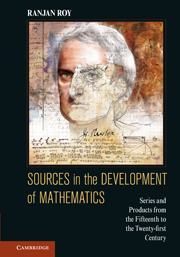 Sources in the Development of Mathematics
Sources in the Development of Mathematics Published online by Cambridge University Press: 05 June 2012
Preliminary Remarks
Up until the seventeenth century, geometry was pursued along the Greek model. Thus, second-order algebraic curves were studied as conic sections, though higher-order curves were also considered. Algebraic relationships among geometric quantities were considered, but algebraic equations were not used to describe geometric objects. In the course of his attempts during the late 1620s to recreate the lost work of Apollonius, it occurred to Fermat that geometry could be studied analytically by expressing curves in terms of algebraic equations. Now conic sections are defined by second-degree equations in two variables, but this new perspective expanded geometry to include curves of any degree. Fermat's work in algebraic geometry was not published in his lifetime, so its influence was not great. But during the 1620s, René Descartes (1596–1650) developed his conception of algebraic geometry and his seminal work, La Géométrie, was published in 1637. The variety of new curves thus made possible, combined with the development of the differential method, spurred the efforts to discover a general method for determining the length of an arc. In the late 1650s, Hendrik van Heuraet (1634–c. 1660) and William Neil(e) (1637–1670) gave a solution to this problem by reducing it to the problem of finding the area under a related curve. In this and other areas, Descartes's new approach to geometry served as a guiding backdrop.
To save this book to your Kindle, first ensure [email protected] is added to your Approved Personal Document E-mail List under your Personal Document Settings on the Manage Your Content and Devices page of your Amazon account. Then enter the ‘name’ part of your Kindle email address below. Find out more about saving to your Kindle.
Note you can select to save to either the @free.kindle.com or @kindle.com variations. ‘@free.kindle.com’ emails are free but can only be saved to your device when it is connected to wi-fi. ‘@kindle.com’ emails can be delivered even when you are not connected to wi-fi, but note that service fees apply.
Find out more about the Kindle Personal Document Service.
To save content items to your account, please confirm that you agree to abide by our usage policies. If this is the first time you use this feature, you will be asked to authorise Cambridge Core to connect with your account. Find out more about saving content to Dropbox.
To save content items to your account, please confirm that you agree to abide by our usage policies. If this is the first time you use this feature, you will be asked to authorise Cambridge Core to connect with your account. Find out more about saving content to Google Drive.